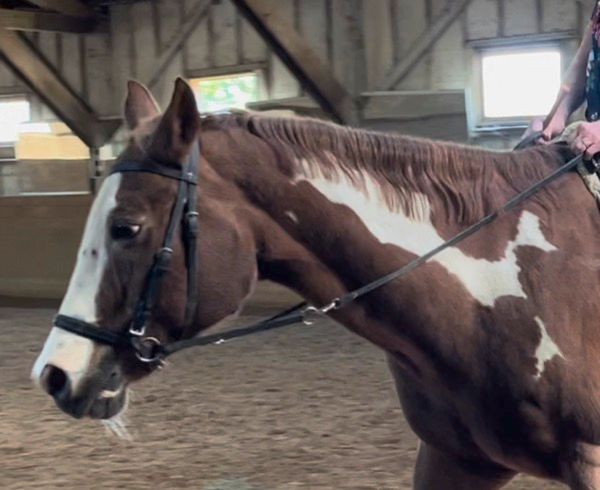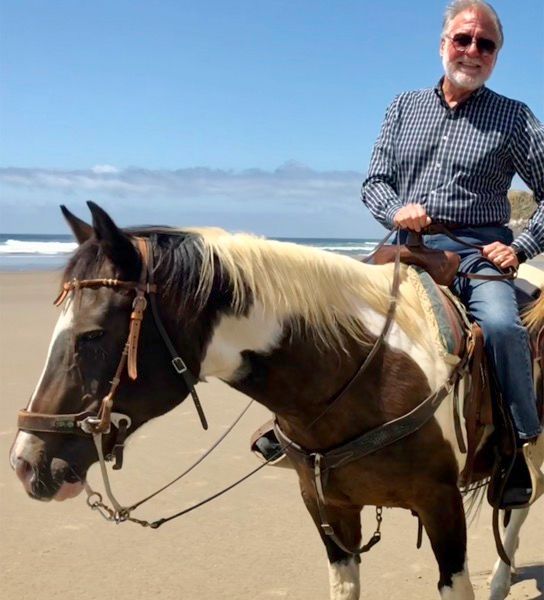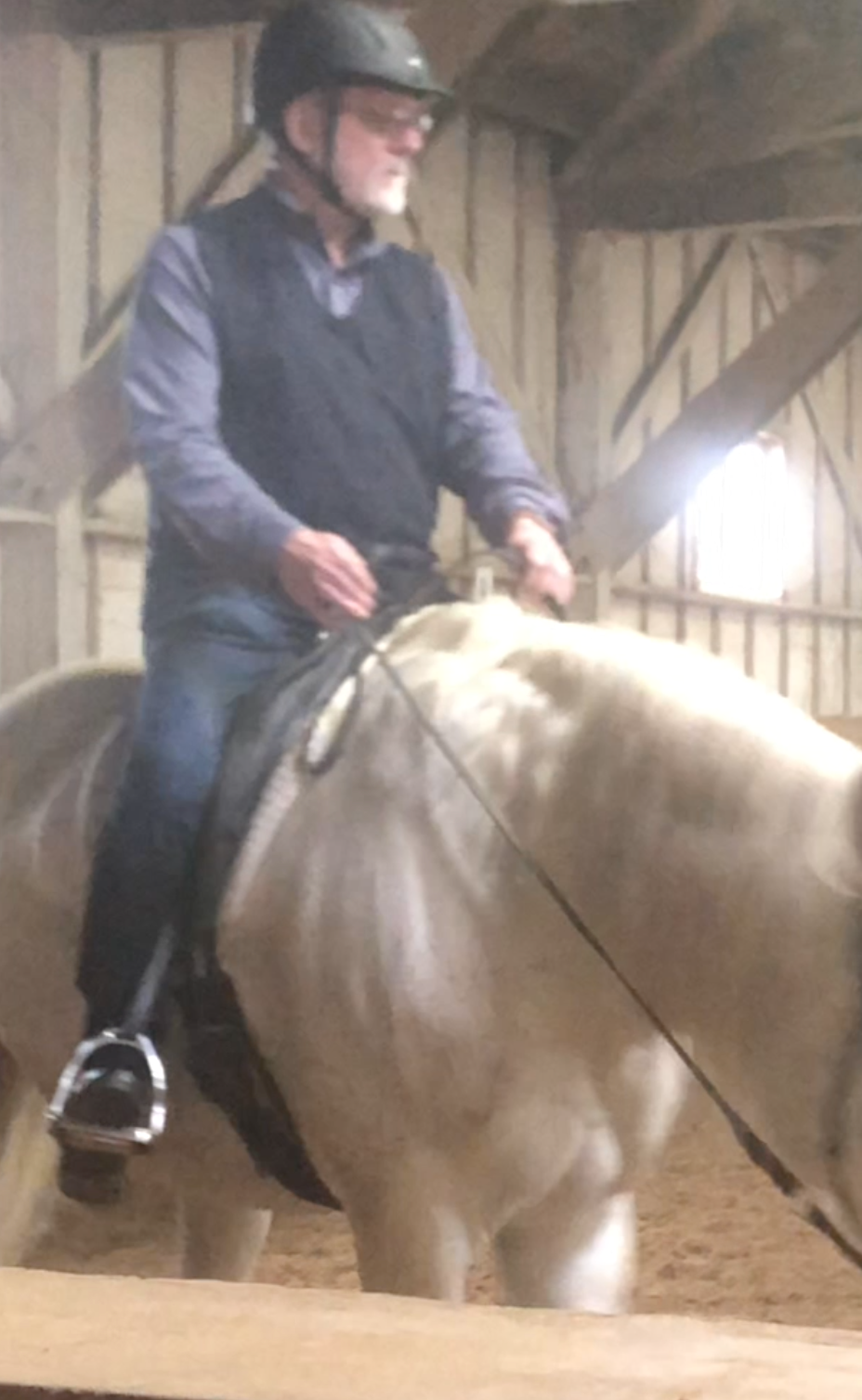Guess what I did today...my horsey adventures
-
Nothing to really add, other than it was a good day today. It took about 10 minutes for Opal to understand that it wasn't going to be just another "walk around in circles" type of day.
I kept messing with her head, asking her to do things that she wasn't expecting, like walking down the center of the arena rather than going in a circle, asking her to stop, back up and then go into a trot from a halt, making some small circles (which can be difficult at the trot if you're feeling lazy), passing to the side (crossing your hind legs), and turning 90 degrees while standing.
I'm nowhere near the level of someone like @jodi is, of course. Still, it's fun. I have no doubt it would be better if I did this 3-4 days a week, for an hour, rather than only for 30 minutes on a Sunday.
Link to videoI should add...
I had a good day last week as well. It seems like, after all this time, Opal and I are beginning to "click," where she's understanding what I'm asking of her. This is the kind of relationship with a horse that should take a couple of weeks, if you own your own. Here, it's taken months.
With Simon, I could just "think" something - turn, trot, canter, halt - and it would happen. With Opal, everything is not a thought, but a request.
You'll notice that I give her a couple of kicks now and then to encourage her to move out. I NEVER had to do that with Simon.
-
Nice video George. I can see that you are light with your hands. That shows in Opal’s quiet demeanour. It also shows that you are a true equestrian.
@Renauda said in Guess what I did today...:
I can see that you are light with your hands.
Thanks. I've been working on that. My instructor stresses the point that with lesson horses, a pull on the reins usually indicates "stop" or "slow down." It should be a signal, with the lightest possible touch, indicating, "I need you to turn your head this way," with most of the real direction coming from your legs and seat.
As I've
complainedsaid, a lesson horse is much more demanding, and you have to pay MUCH more attention to what the horse is doing. WIth Opal, if we're at a good trot, and I lose concentration, like saying something to my instructor, she takes my lack of attention as a signal that she no longer needs to keep moving, and she'll break to a walk.Carrying a crop seems to raise her awareness level, however. Just holding the magic wand in your hand changes her demeanor, and she's much, much more attentive. I'm at the point where I can start to feel her getting a bit sluggish, and a squeeze of my leg, or the most gentle tap on her shoulder with the crop lets her know that slowing down is not in her immediate future, LOL.
Nevertheless, fun.
-
@Renauda said in Guess what I did today...:
I can see that you are light with your hands.
Thanks. I've been working on that. My instructor stresses the point that with lesson horses, a pull on the reins usually indicates "stop" or "slow down." It should be a signal, with the lightest possible touch, indicating, "I need you to turn your head this way," with most of the real direction coming from your legs and seat.
As I've
complainedsaid, a lesson horse is much more demanding, and you have to pay MUCH more attention to what the horse is doing. WIth Opal, if we're at a good trot, and I lose concentration, like saying something to my instructor, she takes my lack of attention as a signal that she no longer needs to keep moving, and she'll break to a walk.Carrying a crop seems to raise her awareness level, however. Just holding the magic wand in your hand changes her demeanor, and she's much, much more attentive. I'm at the point where I can start to feel her getting a bit sluggish, and a squeeze of my leg, or the most gentle tap on her shoulder with the crop lets her know that slowing down is not in her immediate future, LOL.
Nevertheless, fun.
I know what you mean about lesson horses. But I note Opal does not need a martingale. That tells me that previous students have not been too heavy handed on the bit. All the lesson horses I ever had to ride needed a martingale. Didn’t look out of place with an English saddle and snaffle but looked ridiculous with a Western saddle and snaffle.
-
I know what you mean about lesson horses. But I note Opal does not need a martingale. That tells me that previous students have not been too heavy handed on the bit. All the lesson horses I ever had to ride needed a martingale. Didn’t look out of place with an English saddle and snaffle but looked ridiculous with a Western saddle and snaffle.
@Renauda said in Guess what I did today...:
I note Opal does not need a martingale.
Nope. No need. I think she was trained Western, so she tends to keep her head down. The horse Mrs. George rides doesn't use a martingale. As a matter of fact, she rides her horse without a bit!

When we rode in Cannon Beach, Oregon, a few years ago, neither of these trail horses had a bit in their mouths either. But, those were some serious shanks on that nosepiece. Lots of stopping power, LOL.

I would ride Simon in a bosal every now and then.
-
@Renauda said in Guess what I did today...:
I note Opal does not need a martingale.
Nope. No need. I think she was trained Western, so she tends to keep her head down. The horse Mrs. George rides doesn't use a martingale. As a matter of fact, she rides her horse without a bit!

When we rode in Cannon Beach, Oregon, a few years ago, neither of these trail horses had a bit in their mouths either. But, those were some serious shanks on that nosepiece. Lots of stopping power, LOL.

I would ride Simon in a bosal every now and then.
Serious shanks no kidding. That’s a hackamore. I’ve seen some pretty severe ones out there- usually on older horses whose mouths have been ruined by cathedral bits in hands of people who shouldn’t ever sit a horse in the first place.
I often rode my horses with a bosal as well - R. responded well to one - when trail riding or light reining exercises in the arena. When cattle penning/cutting on Hotrodder, a mild curve bit and tie down just in case he threw his head in the excitement of it all.
-
Serious shanks no kidding. That’s a hackamore. I’ve seen some pretty severe ones out there- usually on older horses whose mouths have been ruined by cathedral bits in hands of people who shouldn’t ever sit a horse in the first place.
I often rode my horses with a bosal as well - R. responded well to one - when trail riding or light reining exercises in the arena. When cattle penning/cutting on Hotrodder, a mild curve bit and tie down just in case he threw his head in the excitement of it all.
-
@Renauda said in Guess what I did today...:
light reining exercises in the arena
Cowboy dressage, eh?
I'd love to see you doing that.
-
Another good day with Opal.
Last week, I thought I'd try something different. In all of my previous lessons, I'd follow what my instructor told me to do.
"OK, walk around the arena, and once you've done it a couple of times, change direction and walk around the arena another couple of times."
I found that boring, and I have little doubt that Opal found it boring as well, so, last week, just to mess with Opal's head, I decided I'd do things differently. After all, there's no reason why, during our "warm-up" I can't ask her to get interested in me, pay attention to me, etc. So, I decided to "mess with her head." Once we had gone about half way around, I asked her to walk down the center of the arena.
"Whoa, nobody asks me to do that! Who the hell are you?"
"I'm George, and I'm going to ask you to pay attention to me today, rather than zoning out and phoning it in..."
"Well, then..."
As I mentioned, I had a good lesson last week, so today, I pushed her buttons even more.
During our warm-up, we did all kinds of crazy things, like backing up (do you have any idea how difficult it can be to ask a horse to back up?). I asked her to go across the arena. I asked her to make circles, I asked her to do all the weirdo stuff that I've never done before during warming up.
So, once I had the feel that she was good and ready, I asked her to back up, and then, from there, "C'mon, girl! Gimme a trot!"
And she did.
Link to videoSome horses put their weight on their front quarter, and getting them to move into a trot can be difficult. By asking them to back up, you ask them to shift their weight back, making it easier to move forward.
Just by asking her to pay attention to me, I was able to convey what I was asking her to do, and there was no reason to use a crop today - at all.
She was soft, compliant, and attentive to me.
Then, toward the end of my lesson, we did some more stuff. As I said earlier, I'm nowhere near where @jodi is, and I never will be, but I asked her to move sideways at the walk, keeping her body parallel to the rail while moving sideways. This requires her to almost cross her rear legs while "sliding" to the side. Having accomplished that a couple of times, I asked her to turn 90 degrees from a stand. Again, this is an exercise that "loosens" the horse, and gets it to understand what you're asking. Think about it - if you put your leg on the horse, the horse will naturally respond to that pressure and move away from it. But, in this exercise, you don't want it to move forward at the same time, so it's a conversation between leg and rein. The leg says "move," while the rein says, "yeah, but not forward. Swing your horse's ass around.
Link to videoA very good day today.
At the end, my instructor said, "Excellent."
I'm good for the week!
-
Well, I'm glad y'all had a fun day. I said y'all, because I'm guessing it was a fun day for the horse, too.
Do they ever do anything like trail rides, etc?
@Jolly said in Guess what I did today...:
Do they ever do anything like trail rides, etc?
Nope. Some of the boarders might take their horses off the property, though I doubt it. Besides, there aren't any trails in the area.
Also, getting a trail ride business going is a big deal. You have to have a number of reliable, steady horses who know the drill, regardless of who's on their back. You have to have a few guides, because it would foolhardy to let a bunch of idiots out without supervision. Then there's the legal bs, not to mention liability (It's Illinois, you know).
This barn is almost 100% English riding, and beginners would be hard-pressed to ride in an English saddle (no horn for them to hold onto). So, the expense of buying Western tack would be sky high. Used saddles go for $300 and up; bridles, bits, etc can easily double that cost.
The last time I did a trail ride was in 2019, in Denver. There were around 10 of us, and the guide was explicit that on this 90 minute ride, we are going to do nothing but walk. "If I see you trot or lope (canter), I'll pony you up for the rest of the ride."
-
Always interesting, George! I always thought horses that were well-behaved and seemed to sense what to do, were simply horses with high horse IQ.
Does a horse ever get mad, or have a bad day? Is your horse glad to see you, or is it like "damn, this guy is going to push me around, and I hate that..."
-
Always interesting, George! I always thought horses that were well-behaved and seemed to sense what to do, were simply horses with high horse IQ.
Does a horse ever get mad, or have a bad day? Is your horse glad to see you, or is it like "damn, this guy is going to push me around, and I hate that..."
@Rainman said in Guess what I did today...:
Always interesting, George! I always thought horses that were well-behaved and seemed to sense what to do, were simply horses with high horse IQ.
Horses need to be trained. The biggest thing in training is to gain their trust. Being prey animals, they have an instinctive fear of anything on their backs (like a cougar), and they had an instinctive need to be in a herd (safety). Getting a horse to trust you is a huge endeavor, and can take a long time. Usually it's done in an environment where the horse realizes there's no "getting away" from a human. Being herd animals, the horse begins to understand that being near the human is a source of comfort. From there, one progresses to getting the horse to accept a halter on its face. Then, one teaches the horse that something on its back, like a saddle-pad, will NOT eat it.
It's all about trust, patience, and never EVER fighting with the horse.
Does a horse ever get mad, or have a bad day? Is your horse glad to see you, or is it like "damn, this guy is going to push me around, and I hate that..."
I'm not sure if they actually get mad, per se, but they can have a bad day. If something's hurting, or if something is just not right, they can object, usually by refusing what you're asking.
The process of training is to ask the horse to do something by applying the least amount of "pressure" possible to get it to comply. So, if you're sitting on a horse, and you want it to move forward, the first thing is to increase your "energy". Usually you'll tighten your butt muscles, and the horse might pick up on that and realize that something's new.
"Hmm, I'm standing, and now there's a new sensation. Maybe if I walk, it'll go away."
If the horse walks, you're done. You can release the stimulus. If not, you up the stimulus. A squeeze of your thigh or lower leg will up the ante. If no response, perhaps a quick kick (only one). If that doesn't work, a tap of the crop on the shoulder will.
The same thing applies for just about anything. If you're standing near a horse, and you want it to move it's butt away from you, you push on its ass. If it moves, you're done; if not, continue pushing, perhaps harder. Once the horse lets you know that it'll comply, release the pressure.
That's the basis of it, and there's more, a LOT more, involved, obviously. The dialog that you have with the horse using your leg, butt, and reins all come into play. A horse will sense your shift of weight and turn with you doing nothing other than looking where you want to go.
Link to videoIn this brief video, you see that I'm not using the reins on Opal at all, simply turning my head to my left, and she follows my lead and walks to the left. You might notice, as well, that I'm resting the right rein on the right side of her neck, and she turns to move away from that pressure. This is called "neck-reining," which is used in Western riding. A vaquero (cowboy) needed to have the reins in one hand and a riata (lariat) in the other to rope cattle. Using two hands for reins was impossible. We think Opal had some Western training.
It becomes pretty remarkable, really.

